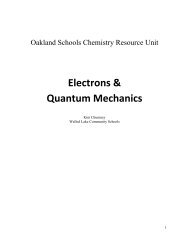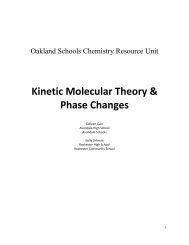Nomenclature and Chemical Reactions - Oakland Schools
Nomenclature and Chemical Reactions - Oakland Schools
Nomenclature and Chemical Reactions - Oakland Schools
You also want an ePaper? Increase the reach of your titles
YUMPU automatically turns print PDFs into web optimized ePapers that Google loves.
Instructional Background Information:<br />
<strong>Nomenclature</strong>/<strong>Chemical</strong> Bonds:<br />
<strong>Nomenclature</strong> involves the naming <strong>and</strong> formula writing for molecular <strong>and</strong> ionic<br />
compounds. Molecular compounds are limited to two nonmetals using the first 20<br />
elements. Ionic compounds are limited to the first 20 elements plus copper, iron, lead,<br />
<strong>and</strong> mercury <strong>and</strong> common ions. Common ions are limited to: acetate, hydroxide,<br />
sulfate, sulfite, nitrate, nitrite, carbonate, <strong>and</strong> ammonium. See examples below:<br />
Ionic Compounds<br />
Type 1<br />
Name the metal, then name the nonmetal-but change ending to ide<br />
Ex. NaCl<br />
AlF 3<br />
sodium chloride<br />
aluminum fluoride<br />
Type 2<br />
Name the metal, <strong>and</strong> then name the polyatomic ion<br />
Ex. NaNO 3 sodium nitrate<br />
Li 3 (PO 4 ) lithium phosphate<br />
Type 3<br />
Transition metals must include charge as a Roman numeral. This is the stock<br />
system.<br />
Ex. Fe 2 O 3<br />
CuCl<br />
CuCl 2<br />
iron (III) oxide<br />
copper (I) chloride<br />
copper (II) chloride<br />
4
















